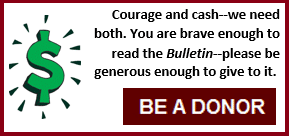The scientist and the nuclear smuggler: unexpected connection
By Egle Murauskaite | August 11, 2014

The complicity of scientists, willing or unwitting, in the smuggling of radioactive materials has been a long-standing concern of the nonproliferation community. After the disintegration of the Soviet Union, the US Cooperative Threat Reduction program offered alternative livelihoods to impoverished nuclear scientists, in hopes of dissuading them from selling their knowledge to governments or terrorists seeking nuclear weapons or materials. A similar, if smaller effort was later launched to redirect Iraqi scientists who had worked on Saddam Hussein’s weapons of mass destruction (WMD) programs to peaceful employment. Today, international threat-reduction and scientist-engagement programs focus on promoting best practices among professionals working with sensitive materials and raising the level of physical security of facilities to prevent diversion or misuse of nuclear material. And new efforts are underway to address growing concerns about the potential radicalization of scientists working in biological and chemical laboratories.
Although the aforementioned efforts represent significant progress in nonproliferation, they fail to recognize an important component of the smuggling process: Scientists are consistently sought out—by their acquaintances or friends of friends—to test the quality of radiological or nuclear materials bound for the black market. Consider, for instance, one of the latest significant cases of nuclear smuggling, in which Garik Dadayan, an Armenian residing in Russia, procured highly enriched uranium (HEU) from contacts in Novosibirsk. In 2003, Georgian authorities apprehended Dadayan when he attempted to sell 270 grams of HEU. He was arrested again in 2010 when he provided 18 grams of HEU for accomplices to sell. Significantly, in 2002—before setting up the deals—Dadayan had approached his acquaintance Hrant Ohanian, a retired scientist at the Yerevan Physics Institute, asking him to test the sample. Ohanian agreed and reportedly was able to test the HEU without difficulty. Similarly, in 2002, six Lithuanian men were caught attempting to sell nearly a kilogram of cesium 137 to a German national. Before arranging the transaction, the men took the material to the Physics Institute in Vilnius to verify its quality.
The scientific community has been used to verify the quality of illicit radiological or nuclear materials for decades. For instance, in 1994, a loosely-connected network of individuals from the former Soviet Union was caught attempting to sell the largest quantity of illicitly obtained HEU known until that time. Eduard Baranov, a former employee at the Obninsk Institute for Physics and Power Engineering (IPPE) in Russia, had diverted HEU from the facility and convinced his neighbor, Alexander Scherbinin, to sell 2.7 kilograms of HEU on his behalf. Scherbinin was introduced to a former Czech nuclear scientist, Jaroslav Vagner, who agreed to assist with the search for buyers—but first, Vagner had a sample of Scherbinin’s HEU tested. His Polish acquaintance, Leszek Niemec, sent it to Landshut, Germany, and successfully verified its high level of enrichment. Another individual connected to this loose network, Vaclav Havlik, a Prague-based trader, procured pellets of low-enriched uranium (LEU) from a different source and also got it tested through an acquaintance before offering it for sale in June 1994.
Most interdicted attempts to sell illicit radioactive materials have involved small groups of loosely-connected individuals collaborating for that specific transaction, and three key features of the illicit radioactive materials market necessitate third-party verification of quality: the highly specialized nature of the product; the lack of expertise of the persons handling it; and the relatively low levels of familiarity and trust among smugglers. By nature, the need for independent verification of illicitly obtained radioactive materials before they are traded is comparable to seeking home value appraisals before a seller and buyer can comfortably close the deal, or requiring an independent audit before two companies complete a merger. Thus, the nonproliferation community should recognize that unscrupulous scientists not only function as the sources of illicit radioactive materials, but also as quality evaluators.
While increasingly effective measures have been instituted to prevent the diversion of radioactive materials from laboratories and research institutes worldwide, these measures are failing to consider the possibility that scientists may be approached by colleagues, acquaintances, or friends to verify the authenticity and quality of illicitly obtained radioactive materials. Assisting with such a quality test is not being treated as behavior as condemnable as diverting nuclear material to private hands, and professional curiosity in the exercise—or perhaps reluctance to get an acquaintance in trouble—often leaves these incidents unreported. Actively encouraging timely notification about requests for outsider material verification could make a big difference in early interdiction efforts. Given the difficulty of obtaining radioactive materials to begin with, such efforts may present a good chance of disrupting or at least seriously delaying radiological and nuclear material smuggling operations. Notably, it has been typical that the sellers of nuclear and radiological materials have been interested in testing quality—not the buyers. Thus, intercepting an operation at such an early stage would also likely offer strong leads to those responsible for diverting the materials to the seller.
Greater awareness within scientific communities and reporting mechanisms for quality verification requests could offer an important addition to the toolkit for curbing proliferation and countering nuclear terrorism efforts.
Editor's note: The views and conclusions expressed in this article are solely those of the author and should not be interpreted as necessarily representing the official policies or positions, either expressed or implied, of START, the US Department of Homeland Security, or CNS.
Together, we make the world safer.
The Bulletin elevates expert voices above the noise. But as an independent nonprofit organization, our operations depend on the support of readers like you. Help us continue to deliver quality journalism that holds leaders accountable. Your support of our work at any level is important. In return, we promise our coverage will be understandable, influential, vigilant, solution-oriented, and fair-minded. Together we can make a difference.














